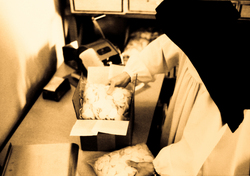 Recently, the National Catholic Register published an
Recently, the National Catholic Register published an
article on the life of nuns at the Valley of Our Lady Monastery, located on 112
acres in Prairie du Sac, outside of Madison, Wisconsin. The author brings out
some salient points that contribute to the “success” of this particular
monastery. Let’s be clear, success is not defined here in terms of secularity but ways that allow for a vocation to thrive according to the Divine
Plan. Let me draw your attention to two things that struck me. Mind you, these
items (see below) are not new at all but they do spell out what is needed to help contribute to
the resurgence of religious life if it’s God’s will. Sadly groups like the Sisters of Mercy, the Sisters of St Joseph, the various Franciscan and Dominican sisters’ congregations to name a few, would think these comments are inaccurate, too shrill and not relevant for the “modern world.” Truthfully, I think these groups want to die because they are too “relevant” matter. BUT when you see women attracted to congregations like this monastery, the Alma Mercy Sisters and the Franciscan Sisters of the Martyr Saint George and not to the secular-looking groups, then one has to ask the hard questions. Having defend the general thesis of the article, let it be known I am not totally in
agreement with Father Mullady’s acceptance of BlackBerries but I can’t have
everything.
ancient contemplative order, Sister Bernarda replied, “To begin with, God.” She
added, “Then, perhaps, the desire for a life of prayer, solitude, simplicity,
with an ancient liturgy in Latin and Gregorian chant, and a simple, traditional
habit. Also, we follow the directives of our order and the Church.” Sister Mary
Bede boiled it down to this: “When you’re looking for a traditional,
habit-wearing, Divine Office-saying order, it narrows down your choices a bit.”
She preferred the Cistercians to some of the newer orders, explaining,
“Definitely, it’s a comfort knowing that the Rule of St. Benedict has
sanctified hundreds of thousands of men and women throughout the ages. It helps
to live a life in faith — that God will work through our superiors and rule to
bring about our sanctification.” When asked what keeps her order so grounded in
its ancient origins and traditions, Sister Mary Dolores responded, “There is a
preservation of identity; progress comes not from something entirely new, but a
returning to the charism of the founders. In tradition, the past is present but
updated.”
survive the decades after Vatican II. Theological consultant for the Institute
on Religious Life in Libertyville, Ill. — a collaborative effort of Catholic
bishops, priests, religious and laity to foster and strengthen vocations to the
consecrated life — Father Mullady said: “Mostly they weathered the changes by
adapting the things that needed to be adapted for young people — there are
sisters on the Internet and carrying BlackBerries — but preserving the habit,
the cloister, silence, reading at table, living in community.”
the article.
